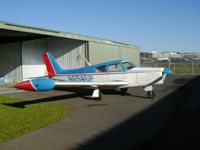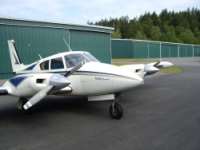Special endorsement required !!! St Barths
1 hr ground school
2 hr dual including @ least 10 T/O & ldngs
30 min. solo,including two full stops
with a rated instructor approved by the
french civil aviation contact 011 590 48 20 20
pay attention to previous posts on how to land
a pa30 all those ding,scrapes,and skid marks are
there by chance, be sure not to float.(pun intended)
tom c
Landings
31 posts
• Page 2 of 3 • 1, 2, 3
-

JIMICS2452 - ICS member

- Posts: 254
- Joined: Sat Mar 09, 2002 9:26 pm
- Location: Pine Shadows Airpark - North Fort Myers, FL
My thought when I saw the video was that he should have landed the other way, uphill, unless the winds were very strong. I've since been told that almost all landings are made in the direction he was attempting to land. I'm not sure of the reason except perhaps that a go around coming the other direction would be a dicey affair.
Clearly, he botched the landing. Too much speed and failure to execute a go around when a landing was not assured. Bummer, a real waste of a plane.
Clearly, he botched the landing. Too much speed and failure to execute a go around when a landing was not assured. Bummer, a real waste of a plane.
-

T210DRVR - ICS member

- Posts: 117
- Joined: Sat May 03, 2008 4:31 am
- Location: So. Oregon
-

JIMICS2452 - ICS member

- Posts: 254
- Joined: Sat Mar 09, 2002 9:26 pm
- Location: Pine Shadows Airpark - North Fort Myers, FL
-

JIMICS2452 - ICS member

- Posts: 254
- Joined: Sat Mar 09, 2002 9:26 pm
- Location: Pine Shadows Airpark - North Fort Myers, FL
-

Zach Grant L1011jock - Technical Advisor
- Posts: 1404
- Joined: Mon Mar 22, 2004 4:35 pm
- Location: Indianapolis KEYE
Landings
Jay: I bought what is called a "Lift Reserve Indicator", years ago when a gentleman named Huntington developed and sold them. It is not called an angle of attack indicator, but performs that function very well. I paid $800 for it back in the days when a $ bought a lot more than it does now, and I feel it was money well spent. I use my PA30 like a super cub at times and the LRI is a welcome calibrator to my seat of the pants feel if I havent been flying for a while.
After Mr. Huntington died the patent for the unit went through several owners (and lawsuits). There are now two different companies that use the basic probe developed by Huntington. The difference in the two companies' products is that one has an electronic colored light display and the other company uses a simple analog gage operated directly by the pressures generated by the probe.
I have the analog pressure operated gage and prefer it to the "flashing colored lights". The probe basically measures the horizontal and vertical air pressure components generated by the flight condition of the airplane and integrates these pressures to move the instrument needle. Therefore it accomodates the load, temperature, density altitude, banking forces, etc to give a true picture of the airplane's flight condition.
The original gage I had took a 3" hole in the panel. The gage sold now is about 2" in diameter and comes with a bracket to mount it on top of the glare shield. I highly recommend mounting the gage at the top of the glare shield, as you can easily check it when on landing approach. I traded my 3" gage for a 2" and removed the gage from the furnished bracket and built a simple bracket that supports the gage with only the top half projecting up through the glare shield. The needle and markings are all in the top half. (I triple checked my layout in the glare shield before I cut out the hole!)
The kit for the system with a heated probe like I have sells for $550 or $450 without the heated proble. At those prices I think it is probably the greatest bang for the buck in aviation today!
You can request full information from prober@iwaynet.net. Al's website has complete information.
A. H. Powers, ICS 2978
PS: I have no financial interest in the company.
After Mr. Huntington died the patent for the unit went through several owners (and lawsuits). There are now two different companies that use the basic probe developed by Huntington. The difference in the two companies' products is that one has an electronic colored light display and the other company uses a simple analog gage operated directly by the pressures generated by the probe.
I have the analog pressure operated gage and prefer it to the "flashing colored lights". The probe basically measures the horizontal and vertical air pressure components generated by the flight condition of the airplane and integrates these pressures to move the instrument needle. Therefore it accomodates the load, temperature, density altitude, banking forces, etc to give a true picture of the airplane's flight condition.
The original gage I had took a 3" hole in the panel. The gage sold now is about 2" in diameter and comes with a bracket to mount it on top of the glare shield. I highly recommend mounting the gage at the top of the glare shield, as you can easily check it when on landing approach. I traded my 3" gage for a 2" and removed the gage from the furnished bracket and built a simple bracket that supports the gage with only the top half projecting up through the glare shield. The needle and markings are all in the top half. (I triple checked my layout in the glare shield before I cut out the hole!)
The kit for the system with a heated probe like I have sells for $550 or $450 without the heated proble. At those prices I think it is probably the greatest bang for the buck in aviation today!
You can request full information from prober@iwaynet.net. Al's website has complete information.
A. H. Powers, ICS 2978
PS: I have no financial interest in the company.
- SLIMDREDGER
- ICS member

- Posts: 306
- Joined: Sat Aug 05, 2000 6:20 pm
31 posts
• Page 2 of 3 • 1, 2, 3
Return to ICS General Membership Discussions
Who is online
Users browsing this forum: No registered users and 24 guests
